[News Focus] Gyeonggi’s sole expansion likely to hamper ‘national balance’
Gyeonggi Province far outstrips Sweden, Greece in population
By Kim Yon-sePublished : July 8, 2021 - 16:15

SEJONG -- South Korea’s demographic figures suggest that the government’s policies for a “balanced national development” via population distribution might be lacking effectiveness, at least so far.
This can be seen from the continuous renewal of Gyeonggi Province’s record-high population. According to the Ministry of Interior and Safety, the population of Gyeonggi surpassed 13.5 million in June for the first time in history.
More than 1 in 4 Koreans were residing in the province, with the number of Gyeonggi residents accounting for 26.1 percent of the nation’s 51.67 million population. The tally for Seoul residents (9.56 million) took up only 18.5 percent of the entire population.
This is mainly attributed to ongoing retreat of Seoul citizens to Gyeonggi due to skyrocketing apartment prices in the capital, which might be desirable with regards to resolving density of Seoul, whose population sharply climbed in the 1970-1980s.
But the problem lies in the fact that a large portion of residents are commuting to Seoul and are not seeking jobs in cities within the province.

Further, Gyeonggi is estimated to have absorbed quite a many people from other metropolitan cities and provinces who wanted to be employed in the capital or its neighboring area, having gradually become a so-called “bedroom community.”
Interior Ministry data showed that the population of Gyeonggi increased by 11,778 on-month in June. In contrast, negative growth was posted in Seoul by 9,365, Daegu by 5,294, Busan by 2,976, Daejeon by 1,054, Ulsan by 806 and Gwangju by 507.
The disparity in demographic figures -- an increase in Gyeonggi and a decline in other major cities -- have generally continued each month over the past several years.
“Past governments sought population distribution by relocating the headquarters of public agencies to provincial cities. Nevertheless, most residents in Seoul and Gyeonggi are reluctant to reside outside Gyeonggi, as most of major enterprises are headquartered in Seoul,” said a labor research analyst.
“These is no doubt that the population decline in major cities and non-Gyeonggi provinces is attributable to the nation’s record-low fertility rates,” he said. “But it is irrefutable that young people nationwide are still rushing to Gyeonggi for better job opportunities in Seoul.”
Though the population of Sejong, which was made an administrative city in 2012, has continued to increase, the figure still stayed under 500,000 at 362,995 as of last month, falling short of Gyeonggi Province’s Gimpo (483,642) and Uijeongbu (461,523).
During the June 2016-June 2021 period, major cities saw significant drops in population -- Seoul reported a slide of more than 423,000, 145,000 in Busan and 87,000 in Daegu.
In contrast, Gyeonggi saw the figure climb 889,000 over the corresponding five years from 12.6 million in June 2016.
Gyeonggi overtook the collective demographic figure for the nation’s largest (Seoul) and second-largest (Busan) cities in August 2019, marking the first time in history since the nation began compiling the data. The figures were 13.19 million vs. 13.16 million.
The gap has continued to widen over the past year. As of June, Gyeonggi outstripped Seoul plus Busan in population by 570,340 -- 13.5 million vs. 12.93 million.
Gyeonggi has a higher population than Belgium (11.63 million), Greece (10.37 million), Portugal (10.16 million), Sweden (10.16 million) and Switzerland (8.71 million). The figure is more than 100 percent higher compared to the respective tallies for Denmark, Norway, Ireland and New Zealand.
Since early 1990s, a series of apartment complexes have been supplied to cities in the province, which are still underway. And many of the cities in the province only function as residential towns with retail services, as a dominant portion of the country’s core enterprises and universities are still headquartered in Seoul.








![[Graphic News] More Koreans say they plan long-distance trips this year](http://res.heraldm.com/phpwas/restmb_idxmake.php?idx=644&simg=/content/image/2024/04/17/20240417050828_0.gif&u=)
![[KH Explains] Hyundai's full hybrid edge to pay off amid slow transition to pure EVs](http://res.heraldm.com/phpwas/restmb_idxmake.php?idx=644&simg=/content/image/2024/04/18/20240418050645_0.jpg&u=20240419100350)





![[From the Scene] Monks, Buddhists hail return of remains of Buddhas](http://res.heraldm.com/phpwas/restmb_idxmake.php?idx=652&simg=/content/image/2024/04/19/20240419050617_0.jpg&u=20240419175937)

![[KH Explains] Hyundai's full hybrid edge to pay off amid slow transition to pure EVs](http://res.heraldm.com/phpwas/restmb_idxmake.php?idx=652&simg=/content/image/2024/04/18/20240418050645_0.jpg&u=20240419100350)

![[Today’s K-pop] Illit drops debut single remix](http://res.heraldm.com/phpwas/restmb_idxmake.php?idx=642&simg=/content/image/2024/04/19/20240419050612_0.jpg&u=)